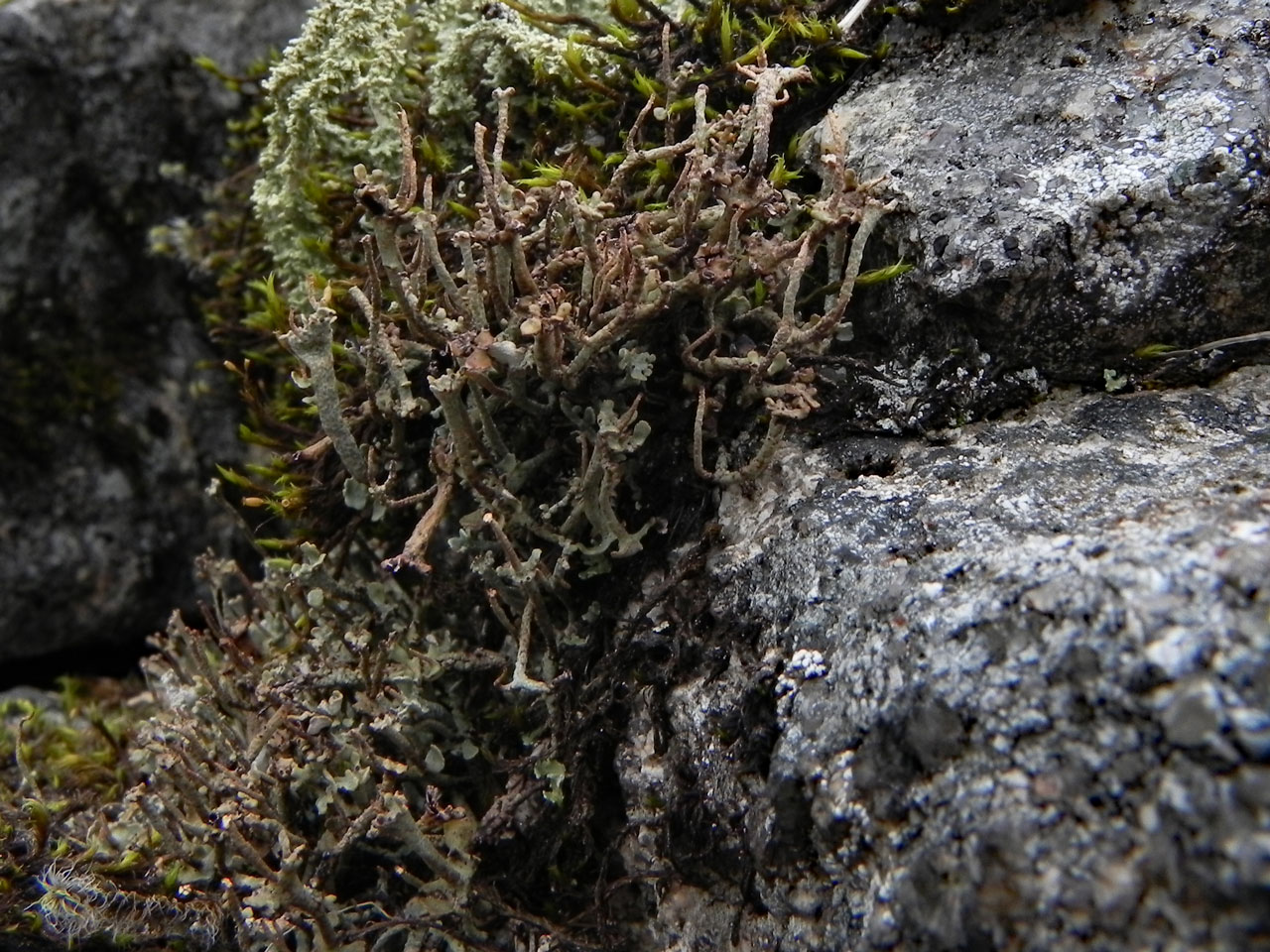A rare montane Stacking Cup Cladonia, with central proliferations from the small cup and grey to grey-brown podetia which reacts K + yellow (atranorin). In the Craingorms, grows in grassy late snow-lie communities, mainly a Deschampsia flexuosa variant of the Salix – Racomitrium snow bed community, U12), rather than Nardus snow patches as sometimes stated (Sanderson, 2010). With the grassy stands it is easily overlooked and needs targeted searching for.
Podetia 0.5–2 cm tall, grey to grey-green, blackened towards the base, sparingly branched above, terminating in narrow cup to 1.5 mm wide or with pointed apices, occasionally proliferating from the centre of the cup, the surface corticate, ± smooth with scattered squamules; soredia absent. Basal squamules 3–8 mm long, indented. Apothecia brown, not observed in British material. Pycnidia dark brown, on the rim of cup, frequent. Thallus C–, K+ yellow, KC–, Pd+ red, UV– (fumarprotocetraric acid and atranorin).
Characterized by the grey colour, central proliferations from the narrow, indistinct cups, the blackened base and K+ yellow reaction. Cladonia verticillata differs in the wider cups and unbranched podetia, while C. phyllophora has marginal proliferations; both these species are K–. Cladonia pulvinata is K– and Pd+ yellow.
Associated with areas of late snow-lie. Sanderson (2010) found that in the Cairngorms the main colonies were deeper into the snow patches than the Nardus snow bed communities (NVC Nardus stricta – Carex bigelowii grass-heath, U7), which were generally too dense for the Cladonia to grow in. Instead it was mostly found just beyond the Nardus communities and within a Deschampsia flexuosa dominated variant of NVC community Salix herbacea – Racomitrium heterostichum snow bed (U12) (Watson et al, 2010). In 2010 it was also found on moss in boulder scree in lat snow-lie areas with a corrie.

The central Highlands (Cairngorms, Ben Alder).
Very localised and likely to be vulnerable to warming temperatures. Sanderson (2010) however found that it was more widespread on parts of the Cairngorm plateau sampled than previous records suggested.
Britain: Vulnerable
Scotland: Priority Taxon for Biodiversity in Scotland
Pino-Bodas, R., Sanderson, N., Cannon, P., Aptroot, A., Coppins, B., Orange, A. & Simkin, J. (2021). Lecanorales: Cladoniaceae, including the genera Cladonia, Pilophorus and Pycnothelia. Revisions of British and Irish Lichens19: 1-45. Link
Sanderson, N. A. (2010) Site Condition Monitoring for Lichens, Cairngorms SSSI. A report by Botanical Survey & Assessment to Scottish Natural Heritage.
Watson, A. Welch, Heslop D. R. E. F. 2010 Deschampsia flexuosa snowbed grassland on granitic mountains in the Cairngorms. Plant Ecology & Diversity 3: 95 – 99.
Text by Neil A Sanderson, based on Pino-Bodas et al (2021)




